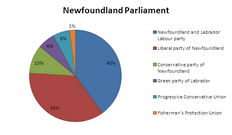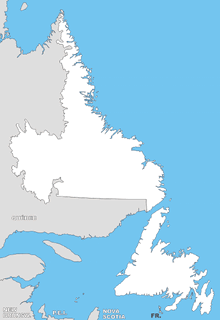| |||||
| Capital | St. John's | ||||
| Largest city | St. John's | ||||
| Other cities | Conception Bay South | ||||
| Language official |
English (official) | ||||
| others | French ,Irish | ||||
| Monarch of Newfoundland | Queen Elizabeth the Second | ||||
| Prime Minister of Newfoundland | Tom Marshall | ||||
| Area | 405,212(156,453 sq mi) km² | ||||
| Population | 514,536 | ||||
| Independence | 1907 (established as dominion), 1950 (established as division of UK) | ||||
| Currency | Newfoundland dollar | ||||
Newfoundland and Labrador is the largest oversea division of the UK, encompassing 405,212 sq km (including territorial waters). It has a total population of over 500,000, around 40% of whom live in the capital of St. John's. The former colony has its own parliament and acts independently of UK proper on most issues.
History[]
Newfoundland and Labrador was first inhabited by native Americans around 9000 years ago and developed their own cultures and languages. In 1001 AD Viking explorer Leif Ericson landed in the area and established a small settlement on Newfoundland (then referred to as Vinland), however the settlement collapsed soon after its establishment.
In 1497 AD, English explorer John Cabot landed on the Island and proclaimed it as English territory. Over the years Newfoundland became a major colony in the British empire (even more so after the loss of the Thirteen colonies). In 1854 the colony voted to form a responsible government instead of joining the dominion of Canada, becoming a dominion itself in 1907. However during the great depression the dominion accumulated massive amounts of debt forcing the government to be absorbed into the UK to pay of its debts in 1948, before regaining its self autonomy in 1950 as an overseas division of the UK. In 1980 the flag was changed to represent the more equal status the Division had to UK proper.
Economy[]
The economy of Newfoundland and Labrador was primarily based on its booming fishing industry up until the 1990's when overfishing lead to the a harsh decline. This decline lead to record levels of unemployment and emigration to Canada. However, this economic decline was offset by the divisions growing service and mining industries which helped to lead to the division's reduced unemployment rate and stabilised its economy in the mid 2000's.
Politics[]

Newfoundland and Labrador is a constitutional monarchy, with The parliament of Newfoundland and Labrador being the highest political power in the division other than the British parliament. The parliament is made up of 50 seats split between several major parties. Newfoundland and Labrador also make up seven seats in the British parliament.
Active parties[]
Newfoundland and Labrador Labour party (NLLP): A center-left party which is the largest party in the division, both by number of votes and number of seats held. It is also the largest Unionist party (a party which supports remaining part of the UK) and often receives most of the Unionist votes. It holds 20 of the 50 seats in the Newfoundland parliament and three of the seven seats in the British parliament.
Liberal party of Newfoundland (LPN): A center-right party which acts as the main opposition to the Labour party. It is the largest Conferderist party (a party which supports becoming part of Canada) and thus receives most of the Conferderist votes. It holds 18 of the 50 seats in the Newfoundland parliament and two of the seven seats in the British parliament.
Conservative party of Newfoundland (CPN): A right wing party which was formed to prevent the increasing power of left wing parties in power. It is the second largest Unionist party though most of the Unionist votes go to the Labour party. It holds five of the 25 seats in the Newfoundland parliament and one seat in the British parliament.
Green party of Labrador (GPL): A left wing party which has a strong view on green politics. It is the second largest Conferderist party in the division though receives few Conferderist votes. It is one of the youngest and fastest growing parties. Is holds three of the 50 seats in the Newfoundland parliament and one seat in the British parliament.
Progressive Conservative Union (PCU): A splitter group from the CPN after the several disputes. It makes three seats in the Newfoundland parliament but no seats in the British parliament.
Fisherman's Protective Union (FPU): A left wing party which main aims are protecting the interests of the fishing industry in the division. It is a Unionist party. However, it doesn't use that fact to attempt to increase the number of votes it receives, which have taken a sharp decline after many Fishing industries went bust in the mid-90's. It holds one of the 50 seats in the Newfoundland parliament but no seats in the British parliament.
Defunct parties[]
United Newfoundland party (UNP): a right wing conservative party that merged with the Conservative Party after losing all but one of its seats in the Newfoundland parliament.
Peoples party of Newfoundland (PPN): A far-left party that dissolved in the mid 1950's due to little success (mostly due to the Red scare).


